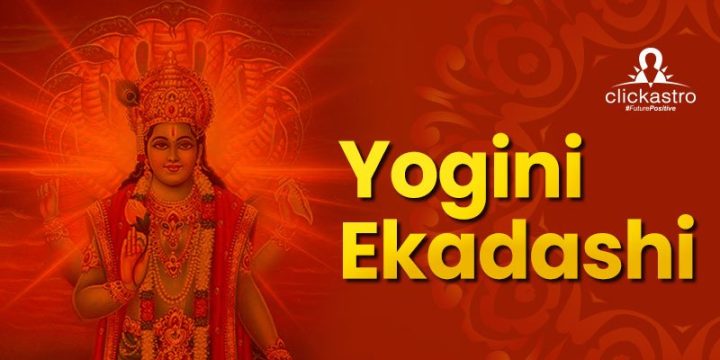When is Yogini Ekadashi?
The 2024 Yogini Ekadashi falls on Tuesday, July 2. It is the 11th tithi of the
Krishna Paksha in the month of Ashadha. Like all Ekadashi, Yogini Ekadashi too sees the worship of Lord Vishnu. Devotees observe fast on this day. Yogini Ekadashi comes after
Nirjala Ekadashi and before Dev Shayini Ekadashi. Details are given below:
The 2024 Yogini Ekadashi falls on Tuesday, July 2
- Ekadashi Tithi Begins – July 01, 10:26 am
- Ekadashi Tithi Ends – July 02, 8:42 am
- Yogini Ekadashi Parana Time – July 03, 5:49 am – 7:10 am
What is the significance of Yogini Ekadashi?
Yogini Ekadashi is a sacred Hindu observance celebrated on the eleventh day of the waxing moon in the Hindu month of Jyeshtha. It holds great spiritual significance for devotees. The term “Yogini” highlights the importance of self-discipline and spiritual practices on this day. Devotees observe fasts, perform rituals, and engage in meditation and prayer to seek blessings and spiritual progress. It is believed that observing
Yogini Ekadashi helps in purifying the mind, attaining self-realization, and deepening one’s connection with the divine. It is a time to reflect on one’s spiritual journey and seek guidance for inner growth and enlightenment.
What are the rituals in Yogini Ekadashi?
Yogini Ekadashi is marked by various rituals and observances that are followed by devotees. Here are some of the common rituals associated with this sacred day:

Fasting:
Devotees observe a strict fast on Yogini Ekadashi, abstaining from consuming food and sometimes even water. The fast is believed to purify the body and mind and enhance spiritual progress.
Worship:
Devotees offer prayers to Lord Vishnu, the preserver, and sustainer of the universe. They decorate the deity’s idol or picture with flowers, incense, and lamps, and perform aarti (ritual waving of lamps) as a sign of devotion.
Meditation and Yoga:
As Yogini Ekadashi emphasizes the significance of yogic practices, devotees engage in meditation, pranayama (breathing exercises), and yoga asanas (postures) to purify the mind, body, and soul. It is a time to deepen one’s spiritual connection and seek inner peace.
Reading Scriptures:
Devotees spend time reading and reciting religious texts, such as the
Bhagavad Gita or Vishnu Sahasranama (a hymn of a thousand names of Lord Vishnu). This practice is believed to bring spiritual knowledge and guidance.
Charity:
Giving to the less fortunate is considered virtuous on Yogini Ekadashi. Devotees donate food, clothes, or money to the needy as an act of compassion and service.
Vrat Katha:
The legend and significance of Yogini Ekadashi are narrated through the recitation of Vrat Katha, a sacred story associated with the day. It serves as a source of inspiration and understanding for devotees.
What is the story behind Yogini Ekadashi?
In the kingdom of Alakapuri, ruled by King Kuvera lived the gardener to the king Hema Mali. It was Hema Mali’s duty to ensure fresh flowers from Mansarovar Lake for the king’s daily worship of Lord Shiva. Hema Mali did his job well. He had a beautiful wife whom he dearly loved – Swarupavati. Hema Mali’s life was perfect. One day King Kuvera, when he reached the temple for the daily worship of Lord Shiva, found to his utter dismay that there were no fresh flowers for the puja.
The king immediately sent a royal official to see what Hema Mali was doing. Hema Mali, at that time, was absorbed in spending time with his wife. The messenger returned and informed the king about this. In anger, King Kuvera ordered Hema Mali to be brought to court. For gross neglect of duty, the king banished him from his kingdom, separated Mali from his wife, and cursed him with leprosy.
Hema Mali begged for pardon but was not given any. Outside the kingdom, Hema Mali roamed around the forest as a leper. Animals also avoided coming anywhere near him. Isolated and alone, Hema Mali cut a dejected figure. One day he found himself in the ashram of Sage Markandeya. Hema Mali told Sage Markandeya everything. Hearing it, the sage advised Hema Mali to observe the Yogini Ekadashi vrat and worship Lord Vishnu. Hema Mali did as was told. He got cured of leprosy. Hema Mali returned to Alakapuri. King Kuvera took him in, and Hema was reunited with his dearest wife. All of this happened because Hema Mali sincerely observed the Yogini Ekadashi vrat.
Another aspect of Yogini Ekadashi is it is also related to Kubera, the lord of wealth. So it is good to worship Lord Kubera alongside Lord Vishnu on Yogini Ekadashi.
Get Your
Wealth Horoscope
What is an Ekadashi?
Ekadashi is a significant observance that falls on the 11th day of both the waxing and waning phases of the moon in the
Hindu lunar calendar. The word “Ekadashi” is derived from two Sanskrit words: “eka,” meaning “eleven,” and “dashi,” meaning “day.” Thus, Ekadashi refers to the 11th day of each lunar phase.
Ekadashi holds great spiritual and religious significance, particularly to those who follow Vaishnavism. Lord Vishnu is one of the principal deities in Hinduism and is revered as the preserver and protector of the universe. Ekadashi is considered an auspicious day dedicated to Lord Vishnu, and it is believed that observing Ekadashi helps devotees gain spiritual merits and seek blessings from the Lord. This is because it was on an Ekadashi day that Lord Vishnu defeated the demon Murdanav and saved Manushyas and Devas from his terror.
The story goes that even after fighting for 1000 years, the demon Murdanav was no closer to getting defeated. Tired Lord Vishnu took a break and had a nap at a cave away from Murdanav. The ten senses and the mind of Lord Vishnu were put at rest. Murdanav soon reached the cave. He was about to swing the sword when a beautiful woman bearing a sword emerged from the body of Lord Vishnu. Murdanav was wonderstruck by this gorgeous woman. He expressed the desire to have her in marriage. The woman agreed to marry Murdanav if he could defeat her in battle. Murdanav agreed and started the battle. But pretty soon, it became clear to Murdanav that he would never harm this woman, so he accepted defeat himself and was slain by the woman.
Lord Vishnu now woke up. Pleased with the woman, Lord Vishnu named her Ekadashi as it was Ekadashi day. Ekadashi was blessed that whoever observed Ekadashi Vrat would enjoy health and prosperity in life.
On Ekadashi, devotees engage in various spiritual activities such as fasting, meditating, chanting Vishnu mantras, and performing prayers and rituals. Some devotees observe a complete fast without consuming any food or water, while others may observe a partial fast by consuming only fruits, milk, and specific Ekadashi-friendly food items.
The significance of fasting during Ekadashi is rooted in the belief that it helps purify the mind, body, and soul, and brings devotees closer to Lord Vishnu.
Explore Online Puja Services
What is Ekadashi Vrat?
Vrat during Ekadashi is of three types – Nirjala Vrat, Sajala Vrat, and Farali Vrat. The vrat where the devotee spends the whole day without eating or drinking anything is called Nirjala Vrat. If the devotee subsists on just liquid food, then it is the Sajala Vrat. Limiting the diet to milk and fruits is called Farali Vrat.
During Ekadashi Vrat, devotees should ensure strict adherence to fasting by abstaining from grains and non-vegetarian food, maintaining purity of body and mind, engaging in prayers and meditation, and seeking the blessings of the deity they worship through devotion and self-discipline.
The observance of Ekadashi Vrat is believed to purify the mind, body, and soul, and to deepen the spiritual connection with the chosen deity. It is seen as an opportunity for devotees to seek spiritual growth, cleanse themselves of sins, and attain the divine grace and blessings associated with the deity they worship. Consistently observing the Ekadashi Vrat rids the body of toxins. The individual will feel light and energetic in life. Observing the Ekadashi vrat also lessens the possibility of cancer by almost 90%.









